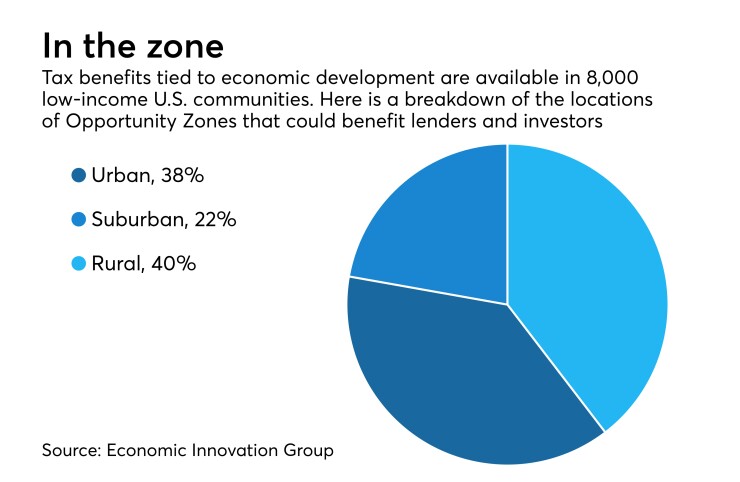Commercial real estate lenders could be getting a shot in the arm at just the right time.
Low-income communities across the country are set to benefit from a new federal rule designed to encourage economic development. Tax benefits will accrue to investors who put money into projects located in thousands of districts designated as Opportunity Zones. That in turn could stimulate more construction lending at a time when overall
Projects that otherwise would not get a second glance may now be appealing, said Roger Shumway, chief credit officer at the $1.3 billion-asset Bank of Utah in Ogden.
“I see it opening up some areas that we haven’t had before,” Shumway said. “I can see it helping us quite a bit.”

According to
“It will be exciting to see new forms of equity flow into the state,” he said.
Some development projects in these communities previously would not have passed financial muster with banks’ credit departments, said George Morrison, a banking attorney at McNair Law Firm in Charleston, S.C.
“Lenders may be more willing to make CRE loans in these projects in these areas with what is going to be an enhanced equity contribution,” Morrison said.
There are two main categories of CRE: loans to develop property and construct buildings, and the permanent mortgage on the finished product. The latter category has been stagnant for banks, but
More than 8,000 communities in every state and U.S. territory have been designated as Opportunity Zones. They range from inner-city neighborhoods in the Bronx, N.Y., and Portland, Ore., to remote rural areas of South Dakota and Wyoming.
Opportunity Zone investments may have great appeal to individuals who want to avoid a huge tax bill on a corporate stock that has soared in value, said Andy Hart, president of Delegate Advisors, a San Francisco wealth management firm.
“For a person who’s got a gain in a highly appreciated tech stock, they’re going to look for Opportunity Zone investments,” Hart said.
The federal tax-cut legislation approved in December (which also created the Opportunity Zone program) has not reduced the appetite for these types of tax benefits, Hart said. There is still demand for ways to minimize or cancel out capital gains taxes over an extended period of time. The program allows those taxes to be deferred over a decade, and in that time Opportunity Zone developments could appreciate in value, and the returns could in effect cancel out the tax debt that had been postponed.
Banks are already lining up resources to lend to Opportunity Zone projects. PNC Financial Services Group in Pittsburgh
Some banks are still in the early stages of evaluating how they might participate, said Jeremy Starkey, president of commercial real estate finance at the $10.8 billion-asset TowneBank in Portsmouth, Va.
“We’re hearing a lot about potential projects,” but they most likely will not get done until next year, Starkey said.
Some types of CRE developments, such as
“The primary benefit of an Opportunity Zone investment is if the property greatly appreciates in value,” Roberts said. “The way you get capital appreciation in rental housing is by raising rents. When you do that, they’re no longer affordable.”
Still, some economically struggling communities are expected to pursue urgently needed financial help. Almost the entire island of Puerto Rico, and the territory’s associated islands, are designated as an Opportunity Zone, José Rafael Fernández, CEO of the $6.7 billion-asset OFG Bancorp in San Juan, Puerto Rico, said during an Oct. 19 conference call.
“Certainly there are opportunities here for the local businesses, and particularly some industries, to help on the rebuilding” after Hurricane Maria, Fernández said during the call. “There’s an interplay here between the rebuilding of the island, the federal funds that are being allocated, and the investors of private capital coming to Puerto Rico.”
It should be welcome news for CRE lenders in any part of the country, said Chris Marinac, an analyst at FIG Partners. The commercial real estate sector has taken its lumps, but this should help spur new lending.
“This is another example where the recent investor concerns about slower loan growth and reduced loan demand are somewhat misplaced,” Marinac said.
Due to intense competition from nonbanks, and to meet regulatory concentration limits, CRE loan portfolios have remained flat or have shrunk in recent quarters at many banks. That has given lenders the room to expand their CRE loan books, Marinac said. Additionally, capital levels have improved, giving them more firepower.
“The capacity for banks to participate in incremental CRE lending is better than most investors understand,” he said.





